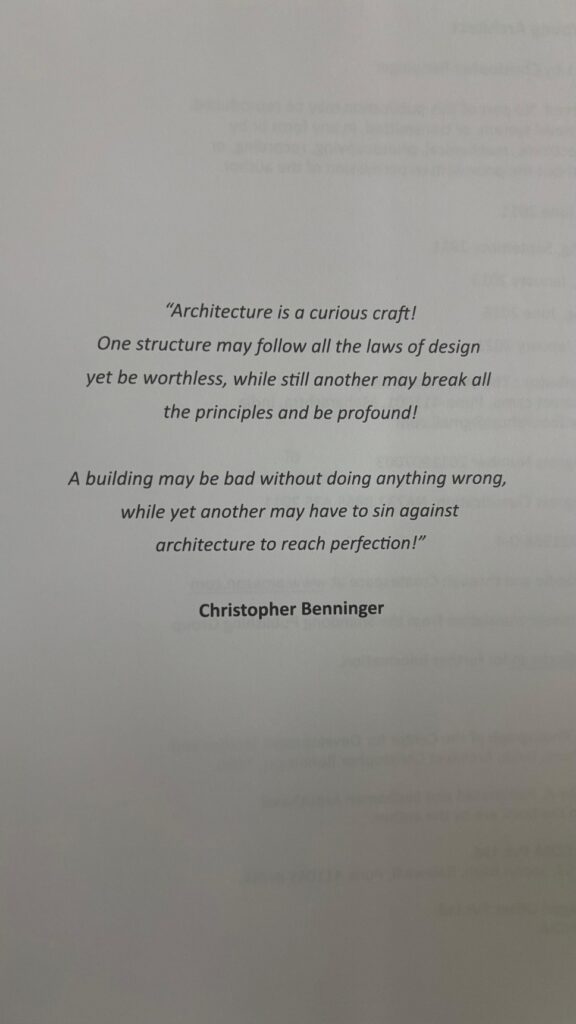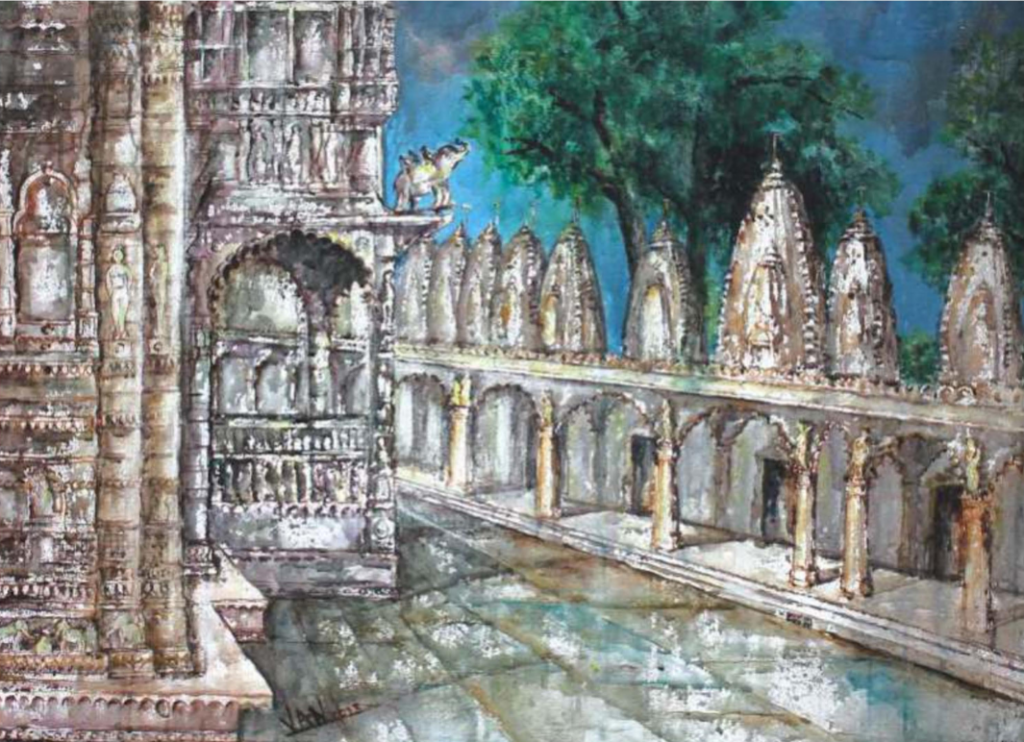~Christopher Benninger Christopher Benninger’s quote reads like an architectural koan mysterious, ironic, and piercingly true. In a profession that prides itself on rules, order, and design logic, Benninger reminds us that architecture is, ultimately, a human art. It does not live by checklists alone. From an architect’s point of view, this quote is both humbling …

~Christopher Benninger
Table of Contents
Christopher Benninger’s quote reads like an architectural koan mysterious, ironic, and piercingly true. In a profession that prides itself on rules, order, and design logic, Benninger reminds us that architecture is, ultimately, a human art. It does not live by checklists alone.
From an architect’s point of view, this quote is both humbling and liberating. It tells us that mastery in architecture is not achieved solely by ticking boxes or following stylistic commandments it’s about tapping into something deeper, something experiential. Architecture, as a craft, sits at the intersection of science and soul, and this quote shines a light on that very tension.
The Illusion of Perfection Through Principles
Let’s start with the first paradox Benninger highlights:
“One structure may follow all the laws of design yet be worthless…”
This is the classic architectural trap where design becomes formulaic, pristine, and perfectly proportioned… yet uninspiring. You could have a building with impeccable alignment, textbook circulation, well-calculated fenestration, and still, it may feel… hollow.
Why?
Because design laws alone do not make good architecture. They are scaffolding, not the soul.
Think of music: a song can be in perfect pitch, follow harmonic theory, and still be forgettable. Likewise, a building can be designed with all the right tools and yet lack narrative, emotion, and presence. It may serve function, but not feeling.
The truly profound architecture the kind that moves people, that earns a place in memory often transcends the written rules and speaks from a deeper intuition.
The Power of Rule-Breakers
“…while still another may break all the principles and be profound!”
Here’s the flip side the rebel’s reward. Some of the most iconic structures in architectural history were once criticized for being “wrong.” Too radical. Too asymmetrical. Too impractical. And yet, they became timeless.
Consider Frank Lloyd Wright’s Fallingwater built over a stream, defying structural orthodoxy. Or Zaha Hadid’s MAXXI Museum its flowing, fragmented geometry threw the rulebook out the window. Or even Le Corbusier’s Ronchamp Chapel so sculptural, it shocked modernists.
Each of these buildings’ broke rules, but in doing so, they redefined what architecture could be. They spoke from intuition, cultural context, material experimentation, and yes, a little architectural rebellion.
Benninger’s point is crystal clear: rules are meant to guide, not to shackle. Profound architecture often arises not by adhering to convention, but by dancing on its edge.
The Mystery of the Mediocre
“A building may be bad without doing anything wrong…”
This is the part that haunts architects.
You design everything “correctly” ergonomics, light, function, proportion. Yet the space feels bland. No magic. No energy. It’s like a dish with all the right ingredients but no flavor.
This could be due to:
- A lack of context – a building ignoring its site, culture, or climate.
- Missing narrative – architecture without a story or purpose.
- Emotional sterility – spaces that don’t consider how humans feel in them.
- Design by committee – diluted concepts, over-revised to mediocrity.
This reminds architects that good architecture is more than doing nothing wrong. It’s about doing something right in a bold, intentional, and emotionally resonant way.
The Necessity of “Sin” for Greatness
“…while yet another may have to sin against architecture to reach perfection!”
This is perhaps the most provocative line. What does it mean to sin against architecture?
To “sin” here isn’t moral it’s metaphorical. It means intentionally violating accepted norms to serve a higher design truth.
Think of:
- A skewed axis in a temple that aligns with a rare astronomical event.
- A brutalist façade softened by handmade tiles.
- A window placed not for symmetry, but to capture a specific tree.
These are decisions that may break formal rules but they honor human experience. Sometimes, to achieve architectural poetry, one must commit a kind of “design heresy.”
Benninger’s brilliance lies in acknowledging that perfection often demands imperfection. That “sinning” against traditional principles may in fact be a deeper act of devotion to architecture’s purpose: to serve life.
Architecture as a Curious Craft
Why does Benninger call architecture a “curious craft”?
Because it is full of contradictions:
- It is technical, yet artistic.
- It is governed by laws, yet thrives on intuition.
- It is planned with rigor, yet judged emotionally.
- It is public, yet deeply personal.
Unlike a pure science, where correct answers exist, or a pure art, where form is free, architecture sits in the gray area. It is a balancing act between ego and empathy, innovation and context, order and chaos.
The best architects learn to live with this ambiguity. They do not seek perfection in symmetry alone, but in the lived experience of space.
Lessons for Architects: Beyond the Obvious
So what can architects take away from this quote in practice? Here are some deeper reflections:
1. Master the Rules, Then Know When to Break Them
Young architects often begin by clinging to rules—because rules offer clarity in the chaos. That’s a good thing. Vitruvius, Corbusier, Neufert they give us the grammar of the craft.
But eventually, like all creative fields, architecture demands an ear for rhythm beyond the beat. You must learn to improvise.
True mastery lies in breaking a rule with purpose because it makes the space better, richer, more alive.
2. Don’t Worship Geometry Worship Meaning
Too often we fall in love with form circles, golden ratios, perfect axes. These are powerful tools, but not sacred ends.
A crooked path that tells a better story is better than a perfect one that tells none. As Benninger suggests, a building can be beautiful because of its “sin,” not despite it.
3. Feel the Space Don’t Just Draw It
Architecture must be felt before it is drawn.
That means immersing yourself in the site. Understanding the light. Listening to the client’s lifestyle. Watching how people move. Feeling the mood of materials.
If a building is designed only in a studio, it may follow rules. But if it is designed from life, it may break them and still succeed.
4. Accept Subjectivity Not Everyone Will Get It
Architecture isn’t math. It’s layered, interpretive, emotional. A building that touches one person deeply may leave another cold.
Don’t design for universal applause. Design with honesty your best chance of creating something truly meaningful.
5. Architecture is Not Just a Product It’s an Experience
We often think architecture is about the final structure. But architecture is also:
- The pause before you enter.
- The scent of old timber.
- The silence of a sanctuary.
- The sound of children running through a corridor.
These are not measurable, but they are unforgettable. And sometimes, they require you to “sin” against orthodoxy.
Christopher Benninger: An Architect Who Walks the Talk
Benninger’s quote reflects his own journey as an architect deeply engaged with India, tradition, and context. He has championed architecture that is rooted, not replicated. His buildings do not shout but they speak volumes.
His work like the Mahindra United World College or the Suzlon One Earth campus shows how modern architecture can be grounded, ethical, and poetic. His statement isn’t just rhetoric it’s reflection.
The Curiosity That Keeps Us Creating
Architecture, like life, resists simple equations.
Benninger’s quote gives architects permission to design with nuance. To recognize that beauty may lie in contradiction. That profound buildings may not be perfect. And that breaking rule, when done with clarity and conviction, is not sin but strategy.
In the end, architecture remains a curious craft because humans are curious creatures. We crave logic, but we’re moved by mystery. We demand function, but we’re inspired by feeling.
So, let’s embrace the paradox.
Let’s sketch with the rigor of reason and the boldness of rebellion.
Let’s design not for perfection but for poetry.
Because sometimes, the most perfect buildings are the ones that dared to be imperfect.






